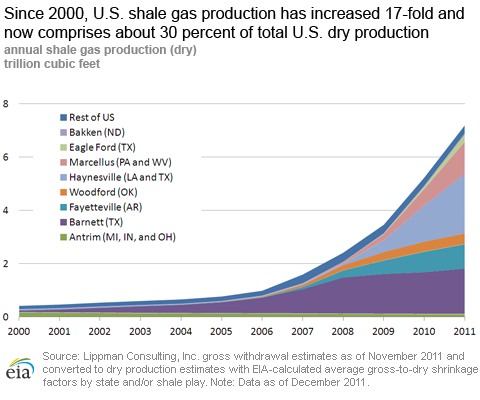In the News:
Storage Inventories at Record Highs
More than midway through the winter heating season (November 1 – March 31), working inventories of natural gas in storage remain at significant margins above previous years' levels. Current storage levels are more than 600 billion cubic feet (Bcf) above the five-year (2007 – 2011) average for this week in the year; and since September 2011, the difference between the current storage level and the five-year average has generally been increasing. (Until September, stocks were at a deficit to the five-year average). Current stocks exceed previous years' levels as well as the five-year average in all three storage regions.
The The abundance in storage inventories is the result of reduced natural gas consumption this year due to a warm winter, and expanded production. This has reduced the need to pull natural gas from storage to meet winter heating demand. As a result of these factors, natural gas prices have come close to 10-year lows. As the heating season comes to an end, storage levels could fall at a more rapid pace, as some inventory owners bring stocks down to required end-of-season balances.
Overview:
(For the Week Ending Wednesday, February 1, 2012)
- Natural gas prices posted net declines during the report week, as patterns of unseasonably warm weather continued across much of the country. The Henry Hub spot price dropped from $2.61 per million British thermal units (MMBtu) last Wednesday to $2.32 per MMBtu yesterday.
- At the New York Mercantile Exchange, the March 2012 contract moved into the near-month position. The contract dropped from $2.769 per MMBtu last Wednesday to $2.382 per MMBtu yesterday.
- Working natural gas in storage fell last week to 2,966 Bcf as of Friday, January 27, according to the U.S. Energy Information Administration's (EIA) Weekly Natural Gas Storage Report (WNGSR). The implied net withdrawal for the week was 132 Bcf.
- The natural gas rotary rig count, as reported by Baker Hughes Incorporated on Friday, January 27, fell by 3 rigs to 777. The oil rig count, on the other hand, rose by 2 rigs to 1,225.
Prices:
Natural gas prices declined in most market locations over the week, as most parts of the country experienced a few days of spring-like weather. At the Henry Hub, the spot price of natural gas declined 29 cents during the report week, to end yesterday at $2.32 per MMBtu. Punxsutawney Phil, apparently bullish on natural gas, saw his shadow this morning, predicting six more weeks of a winter that hasn't yet seemed to materialize. Six weeks of winter would be a reversal from the spring-like temperatures much of the country saw this week. High temperatures were in the 60s and 70s across much of the South for the report week.
On Wednesday, some pricing points in New England showed price increases, the exception to posted double-digit price declines across the rest of the country. The New England region is expected to see some colder temperatures in the coming days. On Wednesday, the price at the Algonquin Citygate, which serves Boston markets, increased 29 cents to $3.39 per MMBtu. However, despite the increase on Wednesday, the Algonquin Citygate price posted a net loss of 51 cents per MMBtu over the report week, and remains far below the price at the same time last year on February 1, 2011, prices for the Algonquin Citygate ended the day at $6.76 per MMBtu. Price increases yesterday were by and large only in New England, with the rest of the Northeast posting declines. The spot price at Transcontinental Pipeline's Zone 6, for delivery into New York City, fell 22 cents yesterday, to end the week at $2.70 per MMBtu, 48 cents per MMBtu below last Wednesday's level.
An exception to the warm, mild winter has been in the Pacific Northwest. In the area, winter has been colder than expected, and power generators have been relying on natural gas for power generation more so than last year, according to analysis and data by BENTEK Energy, LLC (Bentek). In addition, the winter has been drier than normal, which could result in increased natural gas use in the power sector in the summer, as a result of reduced hydropower. Natural gas imports to the West from Canada increased this week, and were above the same week last year by 4.5 percent. But despite the relatively cold weather in the Pacific Northwest, prices remain relatively low. This week, the price at the Sumas trading point, located in Washington State, fell 28 cents to $2.50 per MMBtu.
Supply this week was flat, while demand fell. According to Bentek estimates, dry production rose 0.1 percent, but remains above year-ago levels. Imports from Canada increased slightly, with an increase in imports to the West accounting for most of the increase. LNG imports continued to remain relatively low, falling 12.4 percent from the previous week. Total consumption fell by 13.6 percent, with declines in all major sectors. Residential and commercial demand showed the largest decline, which was related to this week's warm weather. Power demand and industrial demand also posted week over week declines, which were likely weather-related.
At the New York Mercantile Exchange, the price of the March 2012 natural gas contract declined from $2.769 per MMBtu last Wednesday to $2.382 per MMBtu yesterday. The March 2012 contract moved into the near-month position as February 2012 expired on January 27 at $2.678 per MMBtu. While still low compared to recent years, the February contract eked out some gains during its last week of trading.
Storage
Working natural gas in storage fell to 2,966 Bcf as of Friday, January 27, according to EIA's WNGSR. This represents an implied net withdrawal of 132 Bcf, which is 29 percent less than the 5-year average implied net withdrawal of 186 Bcf. Inventories in all three regions posted declines, with the East region contributing the most to this week's implied net withdrawal, with a decrease of 100 Bcf (a 6.4 percent decline from the previous week).
Stocks were 601 Bcf higher than the 5-year average level of 2,365 Bcf, and 586 Bcf higher than last year at this time. Inventories in the Producing Region continue to stand out at 310 Bcf (39.3 percent) above the 5-year average of 789 Bcf. Stocks in the East and West Regions were above their 5-year averages by 218 Bcf (17.4 percent) and 73 Bcf (22.6 percent), respectively.
Temperatures during the week ending January 26 were 5.3 degrees warmer than the 30-year normal temperature and 9.1 degrees warmer than the same period last year. During the week all regions were warmer than normal, particularly the East South Central and West South Central regions in the South averaging 12.0 and 9.7 degrees warmer than normal, respectively. Heating degree-days nationwide were down 16.5 percent from normal and 24.9 percent from last year.
See also:
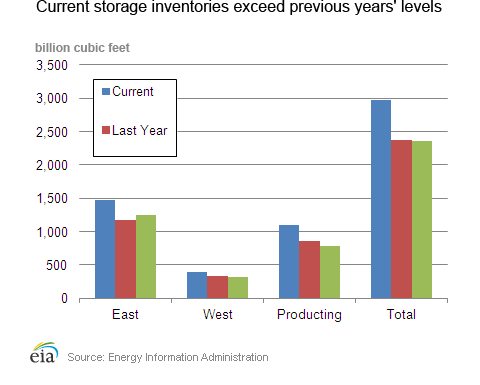
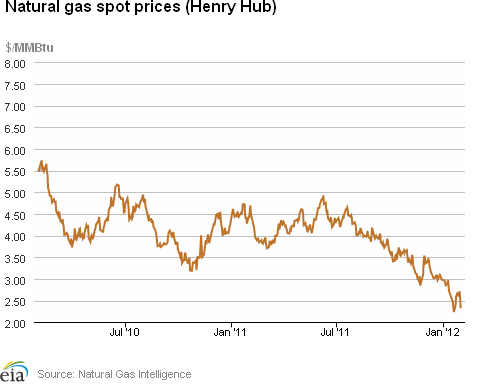
| Spot Prices ($/MMBtu) | Thu, 26-Jan |
Fri, 27-Jan |
Mon, 30-Jan |
Tue, 31-Jan |
Wed, 01-Feb |
|---|---|---|---|---|---|
| Henry Hub | 2.68 |
2.59 |
2.71 |
2.51 |
2.32 |
| New York | 3.00 |
3.54 |
3.14 |
2.92 |
2.70 |
| Chicago | 2.81 |
2.70 |
2.81 |
2.60 |
2.43 |
| Cal. Comp. Avg,* | 2.93 |
2.78 |
2.89 |
2.69 |
2.62 |
| Futures ($/MMBtu) | |||||
| February delivery | 2.605 |
2.678 |
expired |
expired |
expired |
| March delivery | 2.654 |
2.756 |
2.713 |
2.503 |
2.382 |
| April delivery | 2.772 |
2.869 |
2.816 |
2.638 |
2.535 |
| *Avg. of NGI's reported prices for: Malin, PG&E citygate, and Southern California Border Avg. | |||||
| Source: NGI's Daily Gas Price Index | |||||
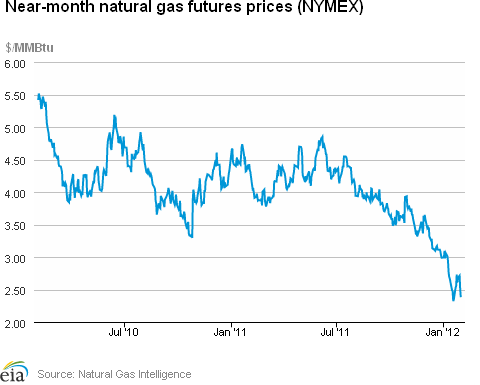
| Working Gas in Underground Storage | ||||
|---|---|---|---|---|
Stocks billion cubic feet (bcf) |
||||
| Region | 1/27/12
|
1/20/12
|
change |
|
| East | 1,471 |
1,571 |
-100
|
|
| West | 396 |
406 |
-10
|
|
| Producing | 1,099 |
1,121 |
-22
|
|
| Total | 2,966 |
3,098 |
-132
|
|
| Source: U.S. Energy Information Administration | ||||
| Working Gas in Underground Storage | |||||
|---|---|---|---|---|---|
Historical Comparisons |
|||||
Year ago (1/27/11) |
5-year average (2007-2011) |
||||
| Region | Stocks (Bcf) |
% change |
Stocks (Bcf) |
% change |
|
| East | 1,181 |
24.6 |
1,253 |
17.4 |
|
| West | 335 |
18.2 |
323 |
22.6 |
|
| Producing | 864 |
27.2 |
789 |
39.3 |
|
| Total | 2,380 |
24.6 |
2,365 |
25.4 |
|
| Source: U.S. Energy Information Administration | |||||
| Temperature -- Heating & Cooling Degree Days (week ending Jan 26) | ||||||||
|---|---|---|---|---|---|---|---|---|
HDD deviation from: |
CDD deviation from: |
|||||||
| Region | HDD Current |
normal |
last year |
CDD Current |
normal |
last year |
||
| New England | 243
|
-32
|
-96
|
0
|
0
|
0
|
||
| Middle Atlantic | 234
|
-29
|
-79
|
0
|
0
|
0
|
||
| E N Central | 264
|
-32
|
-84
|
0
|
0
|
0
|
||
| W N Central | 273
|
-40
|
-86
|
0
|
0
|
0
|
||
| South Atlantic | 130
|
-51
|
-84
|
10
|
2
|
6
|
||
| E S Central | 102
|
-85
|
-115
|
0
|
-1
|
0
|
||
| W S Central | 70
|
-67
|
-93
|
5
|
1
|
5
|
||
| Mountain | 186
|
-42
|
-25
|
0
|
-1
|
0
|
||
| Pacific | 111
|
-6
|
30
|
0
|
-1
|
0
|
||
| United States | 187
|
-37
|
-62
|
2
|
0
|
2
|
||
|
Note: HDD = heating degree-day; CDD = cooling degree-day Source: National Oceanic and Atmospheric Administration | ||||||||
Average temperature (°F)
7-Day Mean ending Jan 26, 2012
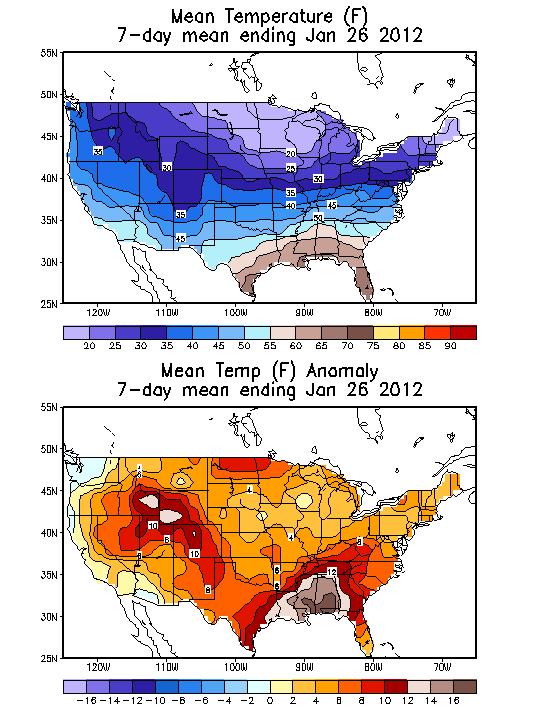
Source: NOAA/National Weather Service
Deviation between average and normal (°F)
7-Day Mean ending Jan 26, 2012

Source: NOAA/National Weather Service
| U.S. Natural Gas Supply - Gas Week: (1/25/12 - 2/1/12) | ||
|---|---|---|
Percent change for week compared with: |
||
last year |
last week |
|
| Gross Production | 7.95%
|
0.07%
|
| Dry Production | 8.89%
|
0.08%
|
| Canadian Imports | -24.81%
|
0.99%
|
| West (Net) | 4.49%
|
14.59%
|
| MidWest (Net) | -19.22%
|
6.56%
|
| Northeast (Net) | -51.68%
|
-19.75%
|
| LNG Imports | -28.35%
|
-12.40%
|
| Total Supply | 4.76%
|
0.04%
|
| Source: BENTEK Energy LLC | ||
| U.S. Consumption - Gas Week: (1/25/12 - 2/1/12) | ||
|---|---|---|
Percent change for week compared with: |
||
last year |
last week |
|
| U.S. Consumption | -12.03%
|
-13.83%
|
| Power | 27.56%
|
-6.61%
|
| Industrial | -5.65%
|
-3.45%
|
| Residential/Commercial | -28.01%
|
-22.13%
|
| Total Demand | -11.61%
|
-13.63%
|
| Source: BENTEK Energy LLC | ||
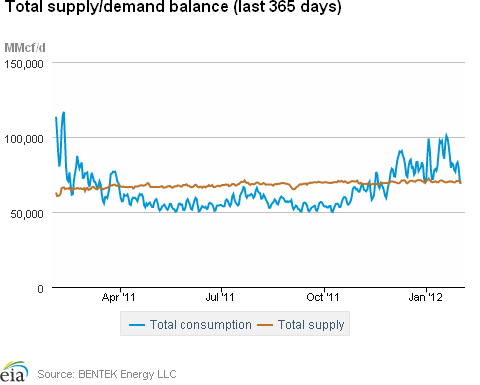
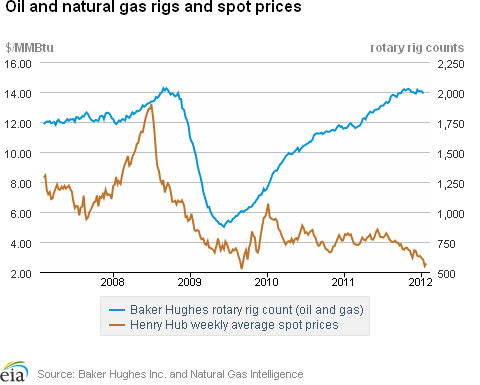
| Rigs | |||
|---|---|---|---|
Fri, January 26, 1900 |
Change from |
||
last week |
last year |
||
| Oil Rigs | 1,225 |
0.16% |
51.17% |
| Natural Gas Rigs | 777 |
-0.38% |
-14.57% |
| Miscellaneous | 6 |
20.00% |
-50.00% |
| Rig Numbers by Type | |||
|---|---|---|---|
Fri, January 26, 1900 |
Change from |
||
last week |
last year |
||
| Vertical | 606 |
-2.10% |
18.58% |
| Horizontal | 1,185 |
0.17% |
21.58% |
| Directional | 217 |
5.34% |
-13.08% |
| Source: Baker Hughes Inc. | |||
